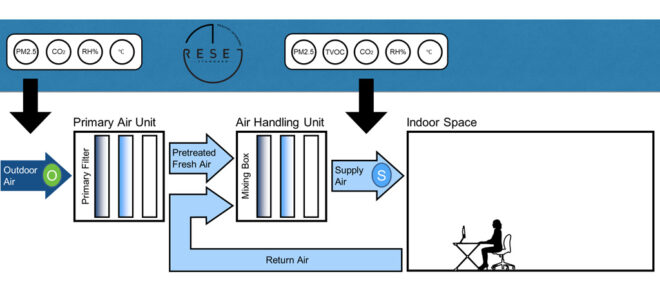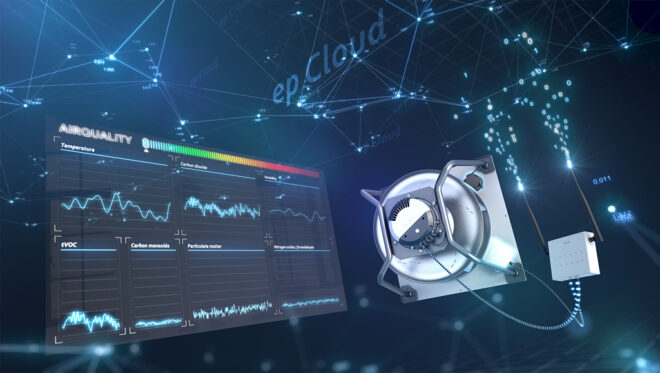The health of their employees is a high priority for most companies. They put numerous measures in place, ranging from ergonomic workstations to company sports groups. The operators of the buildings also want to ensure that the people who are in the rooms feel comfortable and have the right conditions to perform at their best. After all, they pay them rent. A key factor in this is generally ignored: the air quality in the rooms.
Air is quality of life
We can survive weeks without food and days without water, but only a few minutes without air. We breathe in and out up to 15,000 liters of air every day. That is why it is so important that the quality of this air is as high as possible. It is crucial to health, important for our day-to-day productivity and essential for our wellbeing.
As most Europeans spend more than 90 percent of their time indoors, it quickly becomes clear that good air quality is a critical factor here. In indoor spaces, the surrounding climatic conditions and environmental influences affect the air. But the number of people present, furnishings, technical equipment or building materials used also directly influence the quality of the air.
We breathe in and out up to 15,000 liters of air every day. That is why it is so important that the quality of this air is as high as possible.
If temperatures increase outside due to climate change, the inside can quickly become hot and humid, significantly restricting everyday life. A less obvious but perceptible indicator of poor air quality is the carbon dioxide content, for example. A study by the Harvard School of Public Health shows that people’s productivity decreases by 19 percent when the CO2 content in the air increases by 400 ppm. By comparison: European standard 13779 assesses the quality of indoor air with a CO2 content of up to 1,000 ppm as medium, from 1,400 ppm as poor. Gases, spores, tiny particles, or hazardous germs or viruses are also invisible health hazards.
Parameters against the pandemic
Sars-CoV-2 has made this particularly clear to us. We know that the new coronavirus is particularly widely spread via aerosols. The question of how to make indoor spaces safer in this regard is therefore of great importance. Parameters with which the transmission risk can be estimated have already been identified. Because every person exhales CO2, the CO2 concentration in a room indicates how used up the air is. This means the higher the proportion of CO2 particles, the higher the proportion of air that has been breathed several times. In turn, this means the higher the CO2 concentration, the higher the risk of infection. The German Environment Agency has therefore suggested “CO2 traffic lights”: If sensors register a previously defined CO2 value, the room must be ventilated.
Humidity also plays a crucial role in the spread of the virus. For example, a research team from the University of Missouri has shown that, with high humidity, particles can remain in the air for longer and travel further than in dry air. The catch: From a humidity level of less than 40 percent, people’s mucous membranes suffer and are then more susceptible to illness (Figure 2).

Fig. 2: The ideal air humidity zone for people is also a bad climate when it comes to germs and viruses. (Graphic | ebm-papst)
Air quality is not a feeling
It is good to know these parameters. Many building operators, however, are unable to tell their users how often the air is actually replaced or how clean it is. To be able to check the parameters, these must be identified and controlled. And this is currently not technically possible in most buildings. The status quo in the management of indoor air quality is to use your gut feeling. Often people then ventilate rooms more often than is actually necessary – with negative effects on energy efficiency.
Using data to optimize air quality
ebm-papst neo, the start-up of the ventilation and drive specialist in Mulfingen, wants to change this. And is offering the world’s first sensor-based building standard for commercial buildings and their interior spaces in the form of RESET. The standard monitors, communicates, and certifies the air quality in buildings. To achieve this, sensors in the fresh air supply and exhaust and in the inside spaces record various air quality parameters: Temperature, air humidity, carbon dioxide, fine dust (PM2.5) and TVOC, i.e. gases emitted by the materials present indoors (Figure 3). To ensure the accuracy of the data recorded, RESET specifies strict requirements for the precision of the sensors and the type of data transmission.
The data is sent to the ebm-papst Building Connect platform via the Gateway connectivity module. This platform is where the data is processed and analyzed. It can then be provided to the building operator and also be used to optimize the building control systems. The ebm-papst Building Connect platform therefore plays an active role in monitoring indoor air quality and regulating it in an energy-efficient way. Algorithms learn from user behavior, building characteristics and environmental conditions, and, with the help of energy-saving fans, help to create an optimized indoor eco-system.

Fig. 3: The RESET standard uses sensors to record a wide range of air quality parameters in the fresh air supply and exhaust, as well as indoors. (Graphic | ebm-papst)
Count particles – do not estimate them
RESET will also soon offer an index that can indicate the risk of infection in a room. To do this, it uses air parameters such as the CO2 concentration as well as the actual particle load. Filter units mounted on the ceiling can be networked with the system. They can filter not only pollutants and viruses out of the air, but also provide data about the number of particles via a fine dust sensor. This can be used for the RESET index. It compares the measured number of particles in the air with the actual air purification rate – in which aerosolized virus particles are eliminated. As a result, building operators do not have to rely on estimated values and more ventilation than actually needed. They can therefore create clean air in indoor spaces, as energy efficiently as possible.

Fig. 4: The RESET-certified fan from ebm-papst uses sensors and Gateway to transfer a wide range of data to the ebm-papst Building Connect platform, thereby contributing to monitoring and controlling indoor air quality. (Image | ebm-papst)
Quick and easy to implement
The possibility of managing building control with the ebm-papst Building Connect platform has the advantage that you can add an Internet-capable brain to a simple control system. You can, therefore, specify optimized times for a time-controlled ventilation system, thereby controlling the air quality in real time, for example.
The great advantage of the ebm-papst Building Connect platform is that it can be implemented quickly and without a great deal of effort. Experts inspect the rooms and define the position of the sensors. Room plans are used to create a digital twin of the building on the Building Connect platform. Once the sensors have been installed, the system is ready for use. It all takes just a few weeks.
This principle is also behind the RESET-certified fan from ebm-papst. This combination product consists of an energy-saving fan with RESET-certified sensor and gateway (Figure 4). The RESET-certified fan supplies fan data such as speed, vibration, noise, air speed, power consumption, and at the same time, the air quality parameters described above. In this regard, the RESET-certified fan is a true plug-and-play solution: Install, plug in – and breathe deeply.

Leave a comment